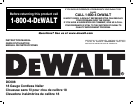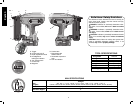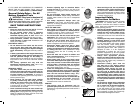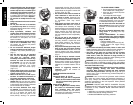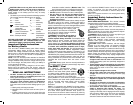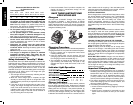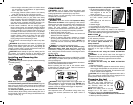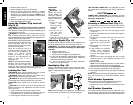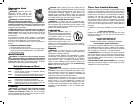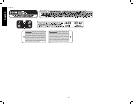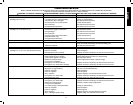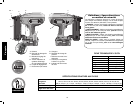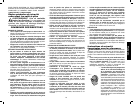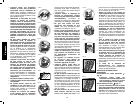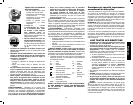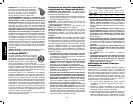
English
3
IF YOU HAVE ANY QUESTIONS OR COMMENTS
ABOUT THIS OR ANY D
EWALT TOOL, CALL US
TOLL FREE AT: 1-800-4-D
EWALT (1-800-433-9258)
General Safety Rules – For All
Battery Operated Tools
WARNING! Read and understand all
instructions. Failure to follow all
instructions listed below may result in electric
shock, fire and/or serious personal injury.
SAVE THESE INSTRUCTIONS
WORK AREA
• Keep your work area clean and well lit. Cluttered
benches and dark areas invite accidents.
• Do not operate power tools in explosive
atmospheres, such as in the presence of
flammable liquids, gases, or dust. Power tools
create sparks which may ignite the dust or fumes.
• Keep bystanders, children, and visitors away
while operating a power tool. Distractions can
cause you to lose control.
ELECTRICAL SAFETY
• Do not abuse the cord. Never use the cord to
carry the tool. Keep cord away from heat, oil,
sharp edges or moving parts. Replace damaged
cords immediately. Damaged cords may create a
fire.
• A battery operated tool with integral batteries or
a separate battery pack must be recharged only
with the specified charger for the battery. A
charger that may be suitable for one type of battery
may create a risk of fire when used with another
battery.
• Use battery operated tool only with the
specifically designed battery pack. Use of any
other batteries may create a risk of fire.
PERSONAL SAFETY
• Stay alert, watch what you are doing and use
common sense when operating a power tool. Do
not use tool while tired or under the influence
of drugs, alcohol, or medication. A moment of
inattention while operating power tools may result in
serious personal injury,
• Dress properly. Do not wear loose clothing
or jewelry. Contain long hair. Keep your hair,
clothing, and gloves away from moving parts.
Loose clothing, jewelry, or long hair can be caught
in moving parts. Air vents often cover moving parts
and should also be avoided.
• Avoid accidental starting. Be sure contact trip
lock-off is in the locked position before inserting
battery pack. Carrying tools with your finger on the
trigger or inserting the battery pack into a tool with
the trigger pulled invites accidents.
• Remove adjusting keys or wrenches before
turning the tool on. A wrench or key that is left
attached to a rotating part of the tool may result in
personal injury.
• Do not overreach. Keep proper footing and
balance at all times. Proper footing and balance
enables better control of the tool in unexpected
situations.
• Use safety equipment. Always wear eye
protection. Dust mask, non-skid safety shoes,
hard hat, or hearing protection must be used for
appropriate conditions.
TOOL USE AND CARE
• Use clamps or other practical way to secure
and support the workpiece to a stable platform.
Holding the work by hand or against your body is
unstable and may lead to a loss of control.
• Do not force tool. Use the correct tool for your
application. The correct tool will do the job better
and safer at the rate for which it is designed.
• Do not use tool if switch does not turn it on
or off. Any tool that cannot be controlled with the
switch is dangerous and must be repaired.
• Disconnect battery pack from tool or place
the switch in the locked or off position before
making any adjustments, changing accessories,
or storing the tool. Such preventative safety
measures reduce the risk of starting the tool
accidentally.
• Store idle tools out of reach of children and
other untrained persons. Tools are dangerous in
the hands of untrained users.
• When battery pack is not in use, keep it away
from other metal objects like: paper clips, coins,
keys, nails, screws, or other small metal objects
that can make a connection from one terminal
to another. Shorting the battery terminals together
may cause sparks, burns, or a fire.
• Check for misalignment or binding of moving
parts, breakage of parts, and any other condition
that may affect the tool’s operation. If damaged,
have the tool serviced before using. Many
accidents are caused by poorly maintained tools.
• Use only accessories that are recommended by
the manufacturer for your model. Accessories
that may be suitable for one tool, may become
hazardous when used on another tool.
SERVICE
• Tool service must be performed only by
qualified repair personnel. Service or maintenance
performed by unqualified personnel could result in a
risk of injury.
• When servicing a tool, use only identical
replacement parts. Follow instructions in
the Maintenance section of this manual.
Use of unauthorized parts or failure to follow
Maintenance Instructions may create a risk
of electric shock or injury.
Important Safety
Instructions for Nailers
WARNING: When using any nailer, all safety
precautions, as outlined below, should be
followed to avoid the risk of death or serious
injury. Read and understand all instructions
before operating the tool.
• Hold tool by insulated gripping surfaces
when performing an operation where the
cutting tool may contact hidden wiring.
Contact with a “live” wire will make exposed
metal parts of the tool “live” and shock the
operator.
• Actuating tool may result in flying debris,
collation material, or dust which could
harm operator’s eyes. Operator and others
in work area MUST wear safety glasses
with side shields. These safety glasses
must conform to ANSI Z87.1 requirements
(approved glasses have “Z87” printed or
stamped on them. It is the employer’s
responsibility to enforce the use of eye
protection equipment by the tool operator
and other people in the work area. (Fig. A)
• Always wear appropriate personal
hearing and other protection during use.
Under some conditions and duration of use,
noise from this product may contribute to
hearing loss. (Fig. A)
• Disconnect battery pack from the
tool when not in use. Always remove
battery pack and remove fasteners from
magazine before leaving the area or
passing the tool to another operator. Do
not carry tool to another work area in
which changing location involves the use
of scaffoldings, stairs, ladders, and the
like, with battery pack connected. Do not
make adjustments, perform maintenance
or clear jammed fasteners while battery
is in place.
• Do not remove, tamper with, or otherwise
cause the tool, trigger, contact trip lock-
off, or contact trip to become inoperable.
Do not tape or tie trigger or contact trip
in the ON position. Do not remove spring
from contact trip. Make daily inspections for
free movement of trigger and contact trip.
Uncontrolled discharge could result.
FIG. B
FIG. A
FIG. C
FIG. D
FIG. E
FIG. F



